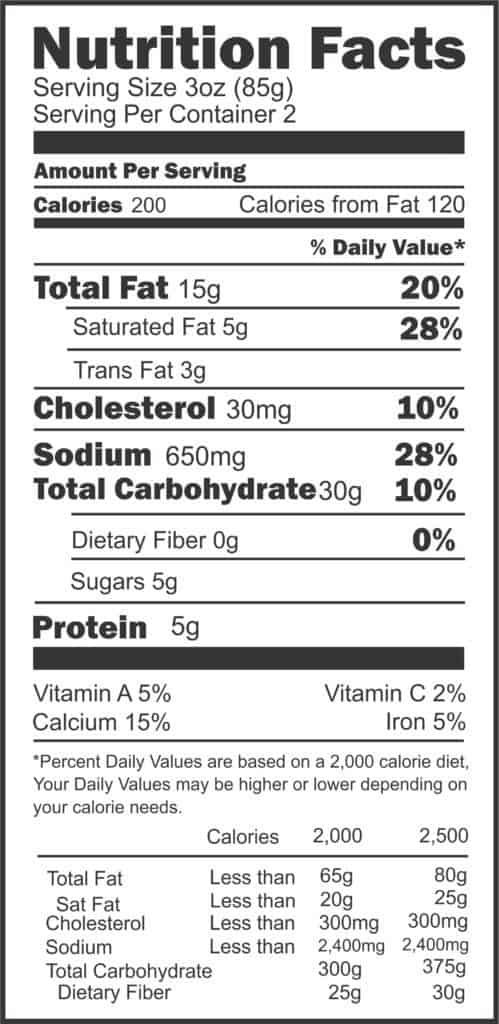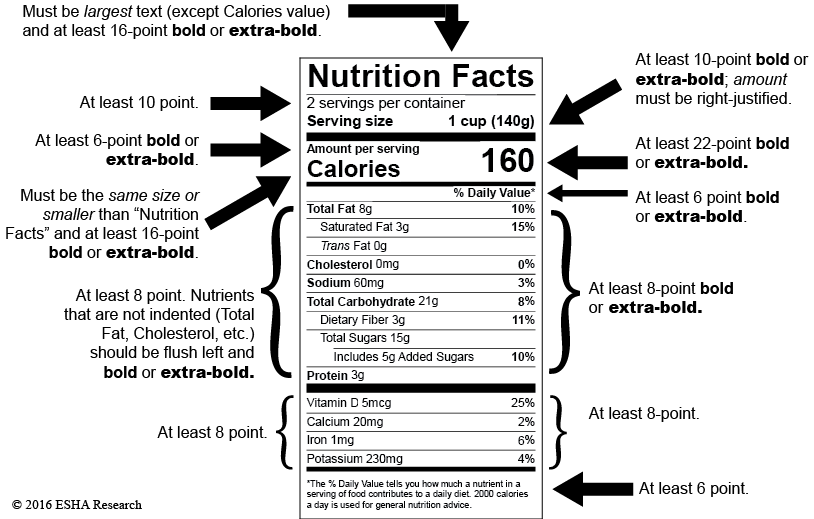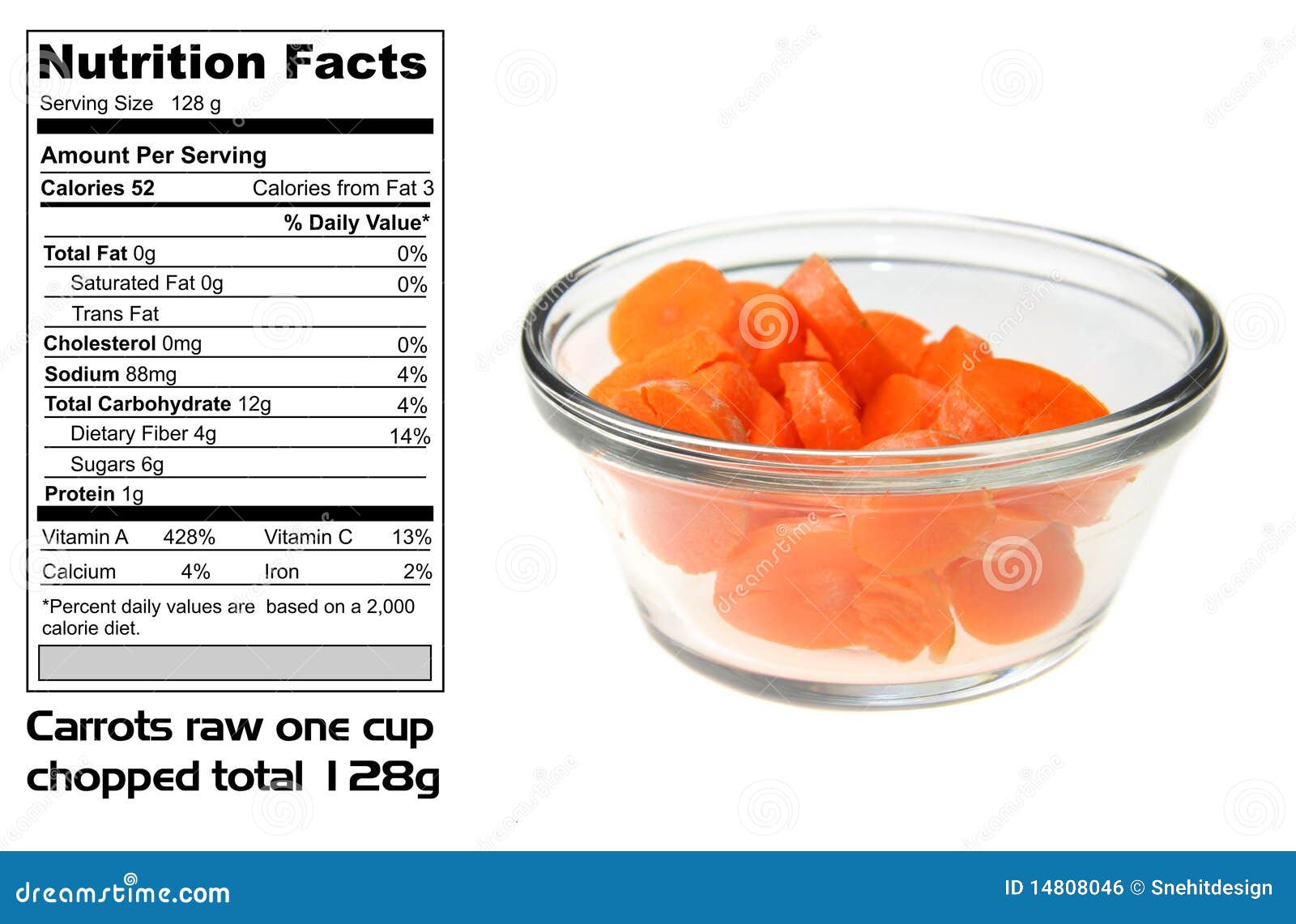45 daily value on food labels
How To Calculate Percent Daily Value for Food Portions The Percent Daily Value is calculated by dividing the amount in a serving by the total recommended daily amount. Multiply that answer by 100, and you've got your %DV! For example: 3g in a serving. 15g recommended per day. 3/15 = 0.2. 0.2 x 100 = 20%. 2.4 Food Labels Flashcards & Practice Test | Quizlet The % daily value on a food label: is based on a 2,000 calorie diet Which of the following foods are exempt from the food labeling law? ready to eat foods as foods at a bakery, deli and/or candy store items The % daily value on a food label is based on our personal dietary goals. false Related questions QUESTION
Percent Daily Value On Food Label - LabelCal What are Percent Daily Values on Food Labels? Percent daily values represent the percentage of the recommended daily intake a single serving of food contains. For instance, if the percent daily value for saturated fat is 45%, that means you are getting almost half of the saturated fat that the FDA recommends you consume in one day.

Daily value on food labels
Daily Value: Definition and How to Calculate It - Insider Found on the nutrition label, the daily value system tells you can help you determine if a product is high or low in particular nutrients. What does daily value mean? Daily value (DV) refers to how much of a nutrient you should consume each day based on a 2,000 calorie diet. You can find daily values for a range of nutrients on the FDA's website. What Does "% Daily Value" Mean on a Food or Supplement Label? The U.S. Food and Drug Administration (FDA) recommends 400 IU, so that's what the Daily Value is set at. The Institute of Medicine recommends getting between 600 and 800 IU per day (as does Health Canada ). Dr. Oz recommends 1,000 IU. Dr. Andrew Weil recommends 2,000 IU. The Linus Pauling Institute recommends 2,000 IU. Percentage of Daily Values Based on a 2000 Calorie Diet The percent daily value on a food label is based on a need of 60 mg a day. Vitamin C also supports normal growth and development, and is necessary for the proper formation of collagen, a structural protein found in your ligaments and skin. To increase your intake, look for foods with more than 20 percent daily value for vitamin C.
Daily value on food labels. The % daily values found on a food label are based on A. a 2,000 ... The % daily values found on a food label are based on A. a 2,000-calorie diet. B. the time of year. C. whether the person is a man or woman. D. whether the food is all-natural or processed. New answers Rating 10 Wallet.ro The % daily values found on a food label are based on a 2,000-calorie diet. Log in for more information. Daily Value on the New Nutrition and Supplement Facts Labels Original Daily Value. Updated Daily Value. Calcium: 1000mg: 1300mg: Dietary Fiber: 25g: 28g: Fat: 65g: 78g: Magnesium: 400mg: 420mg: Manganese: 2mg: 2.3mg: Phosphorus: 1000mg: 1250mg: Potassium ... The Benefits of Food Labels - Delight Medical and Wellness Center Percent Daily Value. Perhaps the most confusing aspect of the nutrition label is the percent daily value. This is the information you'll find alongside the percentage marks on the right hand of the food label. Percent daily value tells you what percentage of your daily value you'll consume of each nutrient per serving you eat. Label: Front of pack labels > Using the front of pack label The GDA value on front of pack labels are based on the average requirements of an adult woman. Using the values for women simplifies front of pack labels and is endorsed by experts as a good benchmark to use for all adults. It also helps consumers to avoid over consumption.
› en › healthy-livingUnderstanding Ingredients on Food Labels | American Heart ... Mar 06, 2017 · Food labels are an important source of information about calories and the nutritional value of the foods you eat, a crucial tool in building a heart-healthy diet. The Nutrition Facts information is always displayed in the same orderly fashion and helps you understand how much of certain nutrients that you need to limit are contained in the ... How To Read Food and Beverage Labels | National Institute on Aging Understanding percent Daily Value (% DV) The percent Daily Value (% DV) tells how much a nutrient in a serving of the food or beverage contributes to a total daily 2,000-calorie diet. Although the average person needs 2,000 calories a day to maintain their weight, individuals may need more or fewer depending on their lifestyle. If you are ... Food labels - NHS eat some beans, pulses, fish, eggs, meat and other protein - aim for 2 portions of fish every week, 1 of which should be oily, such as salmon or mackerel choose unsaturated oils and spreads, and eat them in small amounts drink plenty of fluids - the government recommends 6 to 8 cups or glasses a day The Basics of the Nutrition Facts Label Daily Values are average levels of nutrients based on a person who eats 2,000 calories a day. A food item with a 5% DV of fat provides 5% of the total fat that a person who needs 2,000 calories a day should eat. You may need more or less than 2,000 calories per day.
Percent daily value - Canada.ca Daily values are as followed in the chart below: Nutrient Daily Value (DV) Fat: 65 g: Saturated and trans fats: 20 g: Cholesterol: 300 mg: Sodium: 2400 mg: Carbohydrate: 300 g: Fibre: 25 g: Sugars: no DV: Protein: no DV: Vitamin A: 1000 RE: Vitamin C: 60 mg: Calcium: 1100 mg: Iron: 14 mg: Note: RE = retinol equivalents How well do consumers understand percentage daily value on food labels? Most respondents were able to accurately rate the fat content of five different foods using only the food label information. However, some underestimated food content for some foods. Also, only 29% correctly selected the definition of % daily value for fat (%DV), as "percent of the maximum daily recommended amount of fat." PMID: 10787767 Percent Daily Value: What does it mean? - Drugs.com Percent Daily Value (DV) on the Nutrition Facts label is a guide to the nutrients in one serving of food. For example, if the label lists 15% for calcium, it means that one serving provides 15% of the calcium you need each day. DV s are based on a 2,000-calorie diet for healthy adults. Even if your diet is higher or lower in calories, you can ... Food Labels | CDC Understanding the Nutrition Facts label on food items can help you make healthier choices. The label breaks down the amount of calories, carbs, fat, fiber, protein, and vitamins per serving of the food, making it easier to compare the nutrition of similar products. ... Keep in mind that the % Daily Value of each nutrient, such as total fat of ...
How you can Calculate % of Daily Value on Food Labels How to Calculate % of Daily Value on Food Labels. Step 1. Find the nutrient amount on the food label. Step 2. Look up the total daily recommended amount in the USDA Dietary Guidelines. Step 3. Divide the nutrient amount by the total daily recommended value. Step 4.
The Lows and Highs of Percent Daily Value on the Label The percent Daily Value (%DV) shows how much a nutrient in a serving of food contributes to a total daily diet. The %DV can help you determine if a serving of food is high or low in a nutrient. The...
Lidl's new Good To Give labels explained as supermarket first to help ... 87% of charities have reported needing a greater range of food to provide balanced foods for a healthy diet. Don't miss the latest news from around Scotland and beyond - Sign up to our daily ...
How Well Do Consumers Understand Percentage Daily Value on Food Labels ... How Well Do Consumers Understand Percentage Daily Value on Food Labels? Lisa Levy, MC, MPH , Ruth E. Patterson, PhD, RD , Alan R. Kristal, DrPH , and Sue S. Li, PhD American Journal of Health Promotion 2000 14 : 3 , 157-160
How to Calculate % of Daily Value on Food Labels | livestrong Step 1 Find the nutrient amount on the food label. Step 2 Look up the total daily recommended amount in the USDA Dietary Guidelines. Step 3 Divide the nutrient amount by the total daily recommended value. Step 4 Multiply by 100. Things You'll Need United States Department of Agriculture (USDA) Dietary Guidelines Food label Calculator Tip
the % daily values found on a food label are based on User: the % daily values found on a food label are based on Weegy: The % daily values found on a food label are based on a 2,000-calorie diet. |Score 1|Wallet.ro|Points 251941| User: A consequence of "yo-yo" dieting is that Weegy: A consequence of "yo-yo" dieting is that the body will actually store more fat around the waist. Score 1 User: Positive energy balance is important when
Percent Daily Value (%) on Nutrition Labels: Quick Guide to Reading ... Those are the numbers to remember when reading through the Percent (%) Daily Value column on the right side of the Nutrition Label. 5% is low for a nutrient 20% is high for a nutrient. Some of the nutrients you want high (above 20%): fiber, vitamins and minerals. Some of the nutrients you want low (below 5%): fat, cholesterol, sodium. That's it!

UNDERSTANDING FOOD LABELS - MAKE THE BEST FOOD DECISIONS #fatlossdiet | Reading food labels ...
What Is the Difference Between DRI & Daily Value? - SF Gate This number, called the daily value or DV, is based on the amount of each nutrient needed for a 2,000-calorie-a-day diet. You won't find the daily value on the nutrition facts label. Instead, it's used to calculate the information you will find on the label: the percent daily value.
ods.od.nih.gov › HealthInformation › dailyvaluesDaily Values (DVs) - National Institutes of Health DVs were developed by the U.S. Food and Drug Administration (FDA) to help consumers determine the level of various nutrients in a standard serving of food in relation to their approximate requirement for it. The label actually provides the %DV so that you can see how much (what percentage) a serving of the product contributes to reaching the DV.
templatesumo.com › business › nutritional-factsNutrition Facts: Download 10 Free Nutrition Label Templates These labels listed out the ingredients with their serving size, amounts of serving and percentage of daily value which helps a person in determining a balance and healthy diet. Restaurants, hotels should provide nutritional information about the food before serving.
How well do consumers understand percentage daily value on food labels? Most respondents were able to accurately rate the fat content of five different foods using only the food label information. However, some underestimated food content for some foods. Also, only 29% correctly selected the definition of % daily value for fat (%DV), as "percent of the maximum daily recommended amount of fat." Publication types
farmdocdaily.illinois.edu › 2020 › 09Food Waste and Covid-19: Impacts along the Supply Chain Sep 10, 2020 · Brenna Ellison and Maria Kalaitzandonakes • Brenna Ellison • The Covid-19 pandemic has created massive disruptions in the food system, from farm to fork. In some cases, we have observed and experienced severe food shortages. In others, food cannot reach end consumers and is ultimately wasted. Food waste is not new or novel in our current food system; however, images and reports of whole ...
The Value of Daily Values - Real Food Blends Daily Reference Values (DRVs): these are established for fat, saturated fat, cholesterol, carbohydrates, protein, dietary fiber, sodium, and potassium RDIs typically represent the recommended nutrients of the group with the highest need. For example, the RDI for vitamin D is 20 mcg, which is the RDA for adults over the age of 70.
The Complete Guide to Recommended Daily Intakes, Daily Values, and ... The Daily Value (DV) builds on the RDI, but creates a number meant for everyone that can be put on the labels of food products. In short, the RDI is more specific and the DV is more general. If you are confused, don't worry, this article will clarify it for you, and give you a table with all the numbers.
Table of Daily Values - Canada.ca This document is a two-part table that sets out the recommended amounts of nutrients (the daily value) for specific age groups. These are the reference points upon which the % daily value in the nutrition facts table are based. Part 1 of the table sets out the daily values for macronutrients and sodium for two age groups.








Post a Comment for "45 daily value on food labels"